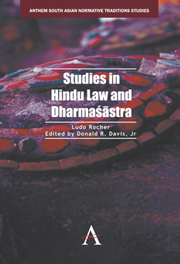Book contents
- Frontmatter
- Contents
- Foreword by Richard W. Lariviere
- Preface
- Abbreviations
- Note on the Edition
- Introduction
- PART ONE THE NATURE OF HINDU LAW
- PART TWO GENERAL TOPICS OF HINDU LAW
- Ancient Hindu Criminal Law
- Hindu Law of Succession: From the Śāstras to Modern Law
- Caste and Occupation in Classical India: The Normative Texts
- Megasthenes on Indian Lawbooks
- The “Ambassador” in Ancient India
- The Status of Minors according to Classical Hindu Law
- Quandoque bonus dormitat Jīmūtavūhanas?
- Notes on Mixed Castes in Classical India
- Inheritance and Srāddha: The Principle of “Spiritual Benefit”
- The Theory of Matrimonial Causes According to the Dharmaśāstra
- Jīmūtavūhana's Dāyabhāga and the Maxim Factum Valet
- The Divinity of Royal Power in Ancient India according to Dharmaśāstra
- A Few Considerations on Monocracy in Ancient India
- PART THREE HINDU LEGAL PROCEDURE
- PART FOUR TECHNICAL STUDIES OF HINDU LAW
- PART FIVE ANGLO-HINDU AND CUSTOMARY LAW
- Bibliography
- Index
The Status of Minors according to Classical Hindu Law
from PART TWO - GENERAL TOPICS OF HINDU LAW
Published online by Cambridge University Press: 05 February 2013
- Frontmatter
- Contents
- Foreword by Richard W. Lariviere
- Preface
- Abbreviations
- Note on the Edition
- Introduction
- PART ONE THE NATURE OF HINDU LAW
- PART TWO GENERAL TOPICS OF HINDU LAW
- Ancient Hindu Criminal Law
- Hindu Law of Succession: From the Śāstras to Modern Law
- Caste and Occupation in Classical India: The Normative Texts
- Megasthenes on Indian Lawbooks
- The “Ambassador” in Ancient India
- The Status of Minors according to Classical Hindu Law
- Quandoque bonus dormitat Jīmūtavūhanas?
- Notes on Mixed Castes in Classical India
- Inheritance and Srāddha: The Principle of “Spiritual Benefit”
- The Theory of Matrimonial Causes According to the Dharmaśāstra
- Jīmūtavūhana's Dāyabhāga and the Maxim Factum Valet
- The Divinity of Royal Power in Ancient India according to Dharmaśāstra
- A Few Considerations on Monocracy in Ancient India
- PART THREE HINDU LEGAL PROCEDURE
- PART FOUR TECHNICAL STUDIES OF HINDU LAW
- PART FIVE ANGLO-HINDU AND CUSTOMARY LAW
- Bibliography
- Index
Summary
Defintion of Minority
The text which has been used most often to define minority in classical Hindu law is a passage from the Nāradasmṛti (1.35), which Jolly translates as follows:
A child is comparable to an embryo up to the eighth year. A youth, who has not yet reached the age of sixteen, is called Pogaṇḍa.
According to the generally accepted interpretation of this passage, minority ends at the time when the young man reaches his sixteenth year, and the Sanskrit technical term for a minor is pogaṇḍa (e.g., Kane 1933: 297: “‘pogaṇḍa’ means a minor who has not attained the 16th year”). Although this interpretation is basically acceptable, a number of remarks are necessary to avoid possible misunderstandings.
Remark 1.
The first remark concerns the accuracy of Jolly's translation. Although its Sanskrit original does not seem to present any major difficulties, it shares at least one feature with most other Sanskrit texts: they lend themselves to translations into modern Western languages, which, without being positively incorrect, do not accurately convey the meaning of the Sanskrit original. Jolly's interpretation of NS 1.35 is a fair example of this kind of translation. In reality Nārada says:
Up to the age of eight years a child (śiśu) is similar to an embryo; up to the age of sixteen, he is a boy (bāla), and is also called pogaṇḍa.
Even this translation needs to be interpreted to the reader who has no access to the Sanskrit text. Nārada states, first, that until he is eight years old, a śiśu has no more rights or duties than he had as an unborn embryo.
- Type
- Chapter
- Information
- Studies in Hindu Law and Dharmasastra , pp. 235 - 248Publisher: Anthem PressPrint publication year: 2012



